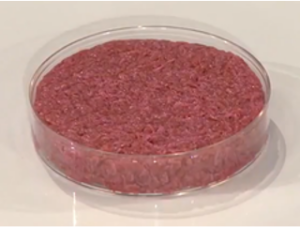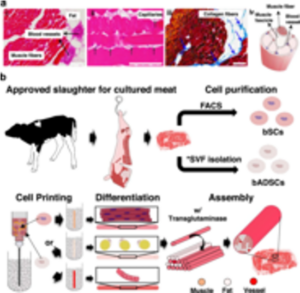
Lab-grown meat will soon be hitting shelves all over the United States within the next few months. Recently Upside Foods and Good Meat, two different companies from the Bay Area in California, have been approved by the Food and Drug Administration (FDA) to produce and sell lab-grown meat in grocery stores all over America1 .The companies plan to grow chicken in steel tanks using cells that come from animal eggs or a special bank of stored cells. A restaurant in San Francisco and another in Washington D.C. will be the first to have meat grown in a laboratory setting on their menus 2. The production and authorization to sell lab-grown meat to the public is a travesty waiting to happen. Lab-grown meat is not real meat, instead, it is a slosh of cells growing in cell cultures in a lab. The nutrients provided by the meat grown in a Petri dish will have inferior nutrient properties compared to an animal that was raised eating natural ingredients like seeds, grass, and plants in nature. Multiple studies have concluded that lab-grown meat is worse for the environment and will grow our carbon footprint faster and will increase energy costs than selling regular meat from natural sources. Lab-grown meat should not be allowed to hit store shelves until extensive research on the effects the grown meat will have on human immune systems and the overall health effects on humans and their offspring.
Normal cells, like the cells that are found in natural meats, replicate through a process called mitosis. When there is not enough room for the cells to continue to divide and replicate, the cells stop dividing through contact inhibition. In the case of meat grown in a lab, scientists are basing the entire process on cells that can divide outside of a living organism and instead are able to grow and divide in test tubes (in vitro). Cells that can grow in vitro are mutated cells that do not abide by natural biological laws. The first discovery of cells that could grow in vitro were HeLa Cells that were derived from cancerous cervical cells. These cancerous cervical cells could divide endlessly in a laboratory and were considered immortal because the cell line would never die due to rapid replication3. Cancerous cells lose the ability for contact inhibition, just like meat grown in labs do, and metastasize to other regions as well. In turn, companies that want to sell meat cultures that were grown outside of the natural state, are selling mutated cells to their consumers. For a cell to continuously replicate and divide, is a mutation commonly found and linked to cancerous cells.
Autoimmune and gut health issues should be the first concern when discussing unnatural meats that were mutated and grown by scientists in a laboratory. Everything our bodies consumes, and digest affects our health and daily lives. The autoimmune system is an intricate system that can be tipped from its balance quickly. A few known risks to cause autoimmune diseases include environmental agents like foods, foreign cells, and infectious organisms 4. Recent epidemiological studies have confirmed that about 3-5% of westernized societies worldwide are experiencing an influx of autoimmune diseases. Autoimmune diseases like multiple sclerosis (MS), type 1 diabetes (T1D), inflammatory bowel diseases, and autoimmune thyroiditis are steadily increasing 5. Through observations of the population, researchers have deemed environmental factors as the main cause for the increase in autoimmune diseases, rather than genetic factors, which are the main drivers in evolutionary processes 5. This is evident that through the food that we ingest and the pollutants that we surround ourselves with are causing abnormalities that could be prevented. So, producing and selling genetically modified and grown meat is not the way that society should be looking at the problem. Lab-grown meat is going to make things worse for the world.
Gut health is another main concern with the production and distribution of cultured meat. Whatever we digest the microbes in our gut also eat and digest them too. The gut is as important as our immune system because the gut breaks down foods that we eat and takes in the nutrients that our body needs for necessary day-to-day functions. Recent research studies showed that the microbiome in our gut can affect every organ in our body 7. It is currently understood that eating too many processed foods is linked to having poor gut health, and over the last decade as people and scientists have tried to create artificial selections the quality of meat produced has decreased greatly 8. Whenever a highly processed food is introduced, it would be irresponsible to call it healthier or better than a natural component, and it should not be different when considering cultivated genetically mortified meat.
Common arguments made in favor of cultivated meat production are that it will improve human health, the planet, and it would save the lives of innocent animals. These arguments should be taken with a grain of salt when being considered as valid arguments in favor of the production and cultivation of bioengineered meat.
When lab-grown meat is argued as healthier for humans, it should be added that it is only healthier than natural meats in the short-term. Lab-grown meats are grown in highly refined growth media that enable the cells to multiply quicker. This is currently a similar media that biomedical engineers use to produce pharmaceuticals. Which in turn raises the question: is cultured meat cells a food product that humans should be consuming or is it a pharmaceutical product 9? Furthermore, during meat cultivation, antibiotics are used to prevent illnesses that are commonly found in meats like salmonella and E. coli. This will lead to antibiotic resistance which is already on track to be the world’s biggest public health concern that humans will encounter within the next few decades 10. Advancements that affect humans should look at the short-term benefits and the long-term effects they will have on society.

Another major argument that is argued when discussing lab-grown meat is that it does not harm the cows and the chickens that are being “maliciously” murdered for human food. This is not the case; unborn calves and cows are murdered for producing and growing cultured meat. For the cells to grow, the cells must sit and incubate as they grow in fetal bovine serum (FBS).Fetal bovine serum is the growth supplement for the cells to grow in cell cultures efficiently that have the perfect amount of cow hormones to allow cell growth. The collection of FBS is harmful to calves that are in vivo and the mother cow. FBS is taken from bovine fetuses that are then drained from pregnant cows during their slaughter 10. Therefore, the argument should not be made that lab-grown meat is more humane than eating natural meat. Killing and draining pregnant cows and their fetuses for their hormones is unethical. If ethical scientific practices are being taken place when draining and killing cows, then it is only right that the whole cow is used for either scientific purposes or eaten. Which completely defeats the idea of being humane to animals. Moving away from using FBS would be challenging for the advancement of cultured meats, because FBS is the only known hormone that will efficiently and effectively grow the cells into cultured meats. It would take more engineered biotechnology to create a hormone that grows the cells that would not use or harm animals, which leads back to the previous argument of the health benefits and nutrition that comes from engineered pharmaceutical foods.
The nutrients that are offered by genetically modified cells to create cultured meat are not comparable to the nutrients that humans gain from eating meat that naturally comes from cows and chickens. Free – roaming chickens and cows are able to select the foods that they ingest creating a wide range of phytonutrients, whereas the meat that is grown in a lab will never be exposed to the different nutrients that comes naturally from what the animals eat, then directly to the humans that eat them 8. Natural meats are traditionally dense foods that have omega-3s, fatty acids, high-quality proteins, with vitamins and minerals that are consumed by animals, that will never naturally be found in lab-grown meat. Instead, these proteins, vitamins, and minerals that are beneficial for human health will be placed by scientists but will never fully mimic naturally occurring meat benefits.

A few other problems that are concerning cultured meat are the amount of energy it takes to grow the meat, and the increased carbon footprint that would impact earth’s atmosphere. Recent studies performed by University of California–Davis investigated the effects the production of lab-grown meat would have on the atmosphere and hypothesized the emission of greenhouse gases emitted during production. Instead of lab-grown meat helping decrease our carbon footprint and emission of greenhouse gases, the study found that the production of meat would increase the world’s carbon footprint by at least four to 25 times more than the current average producing natural meat that comes from cows and chickens 9. Another study reported that there is about three to fourteen kilograms of carbon dioxide emitted per one kilogram of cultivated meat produced 14. This is genuinely concerning for the environment because with every kilogram of meat that is produced there is an emission of 14x more carbon dioxide. It also takes cell cultures about two to eight weeks to be at the appropriate weight to be sold to consumers in stores and in restaurants 15. Greenhouse emissions are a threat the whole two to eight weeks that the cells are growing. That means there will be constant emissions of greenhouses gases that are increasing the earth’s temperature and aiding in the early onset of global warming. The emission of greenhouse gas does not come directly from the growth of cells into meat culture, it comes from the energy sources that are used to generate the bioreactors which is the machine that will grow and incubate the cells until they are able to be sold as meat. If the companies that are preparing themselves to sell this meat in stores, can manage to find a way to combats the current challenges of raising the worlds carbon footprint by 25 times more than the current greenhouse gas emission, then lab-grown meat might look more appealing through the eyes of a meteorologist. However, with the recent data that there is corresponding to the production and storage of the lab-grown meat the greenhouse gas emission that the labs produce and the toxins that are released during the process do not look pleasing. In result of constant store and gas emissions for production, the cost to produce this meat will be higher than it is for natural meat and therefore the price to purchase cultivated meat will be higher than it is currently to by meat.
Lab-grown meat is an issue that should be investigated more thoroughly before it hits store shelves and tables at restaurants. As of right now, with the research and data that we already know about cultivated meat, the approval by the FDA should have never even been considered. Health factors in question, and the emission of greenhouse gas emissions into the atmosphere are serious concerns not considered before the approval. It seems like there is no care for nutrition or value for the earth’s atmosphere, instead it seems like it is more about quantity of meat that can be produced than it is about quality. Lab-grown meat is a way for corporations to produce more products quicker for a quick profit and does not care about the effects that cultivated meat will have on people that ingest it, and for people in general.
- Thompson, J. (n.d.). Lab-grown meat approved for sale: What you need to know. Scientific American. Retrieved November 1, 2023, from https://www.scientificamerican.com/article/lab-grown-meat-approved-for-sale-what-you-need-to-know/ ↵
- Thompson, J. (n.d.). Lab-grown meat approved for sale: What you need to know. Scientific American. Retrieved November 1, 2023, from https://www.scientificamerican.com/article/lab-grown-meat-approved-for-sale-what-you-need-to-know/ ↵
- Hela cells. (n.d.). Office of Science Policy. Retrieved November 1, 2023, from https://osp.od.nih.gov/hela-cells/ ↵
- Kalyanaraman, Balaraman. “Teaching the basics of cancer metabolism: Developing antitumor strategies by exploiting the differences between normal and cancer cell metabolism.” Redox biology 12 (2017): 833-842. Doi: 10.1016/j.redox.2017.04.018 ↵
- Institute of Medicine (US) Board on Health Promotion and Disease Prevention. Vaccine Safety Forum: Summaries of Two Workshops. Washington (DC): National Academies Press (US); 1997. Genetic Factors Affecting Development of Autoimmunity. Available from: https://www.ncbi.nlm.nih.gov/books/NBK232995/ ↵
- Institute of Medicine (US) Board on Health Promotion and Disease Prevention. Vaccine Safety Forum: Summaries of Two Workshops. Washington (DC): National Academies Press (US); 1997. Genetic Factors Affecting Development of Autoimmunity. Available from: https://www.ncbi.nlm.nih.gov/books/NBK232995/ ↵
- Mazzucca, Camilla Barbero et al. “How to Tackle the Relationship between Autoimmune Diseases and Diet: Well Begun Is Half-Done.” Nutrients 13,11 3956. 5 Nov. 2021, doi:10.3390/nu13113956 ↵
- Services, D. of H. & H. (n.d.). Gut health. Retrieved September 28, 2023, from http://www.betterhealth.vic.gov.au/health/healthyliving/gut-health ↵
- Chen, Binlong et al. “Gut microbiota and meat quality.” Frontiers in microbiology 13 951726. 23 Aug. 2022, doi:10.3389/fmicb.2022.951726 ↵
- Quinton, A. M. (2023, May 22). Lab-grown meat’s carbon footprint potentially worse than retail beef. UC Davis. https://www.ucdavis.edu/food/news/lab-grown-meat-carbon-footprint-worse-beef ↵
- Quinton, A. M. (2023, May 22). Lab-grown meat’s carbon footprint potentially worse than retail beef. UC Davis. https://www.ucdavis.edu/food/news/lab-grown-meat-carbon-footprint-worse-beef ↵
- Services, D. of H. & H. (n.d.). Gut health. Retrieved September 28, 2023, from http://www.betterhealth.vic.gov.au/health/healthyliving/gut-health ↵
- Chen, Binlong et al. “Gut microbiota and meat quality.” Frontiers in microbiology 13 951726. 23 Aug. 2022, doi:10.3389/fmicb.2022.951726 ↵
- Jochems, Carlo E A et al. “The use of fetal bovine serum: ethical or scientific problem?.” Alternatives to laboratory animals: ATLA 30,2 (2002): 219-27. doi:10.1177/026119290203000208 ↵
- Here’s what we know about lab-grown meat and climate change. (n.d.). MIT Technology Review. Retrieved September 29, 2023, from https://www.technologyreview.com/2023/07/03/1075809/lab-grown-meat-climate-change/ ↵


